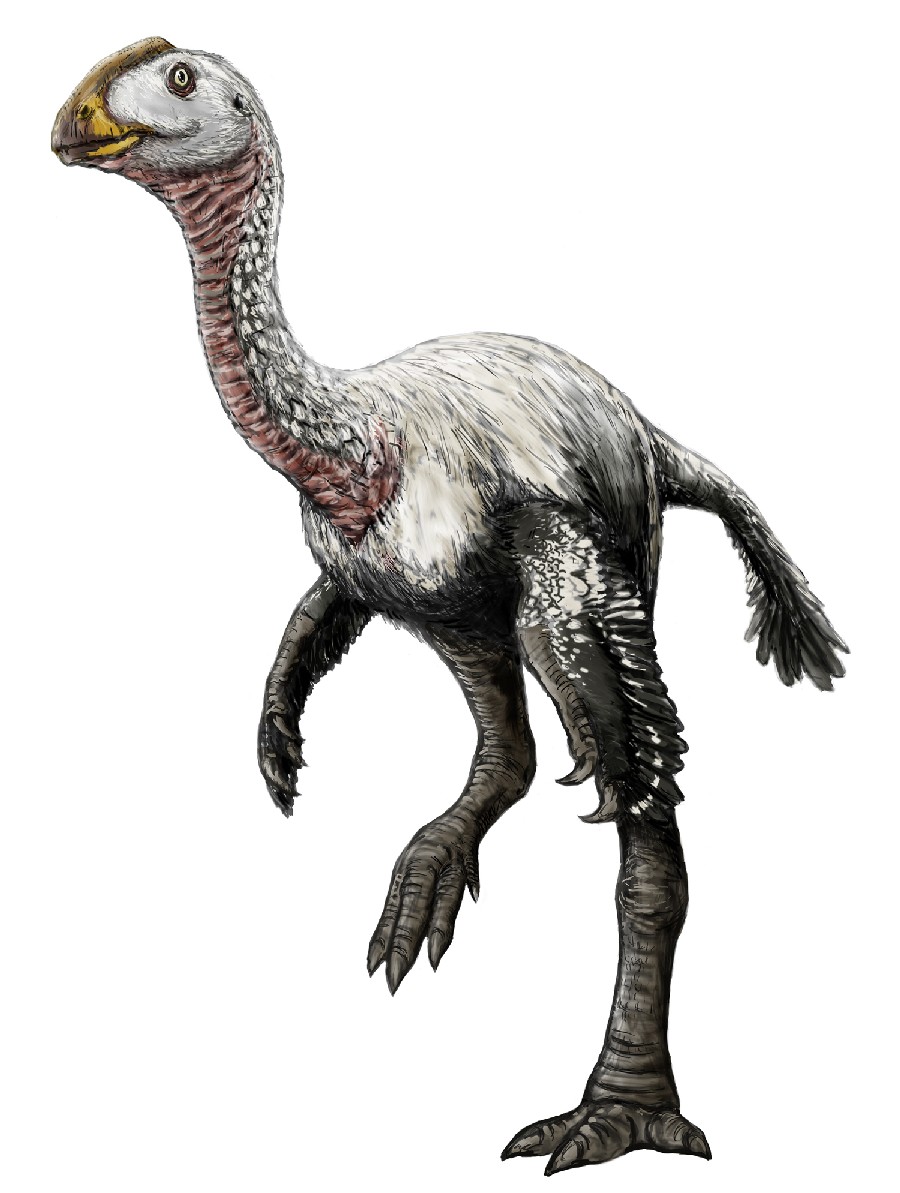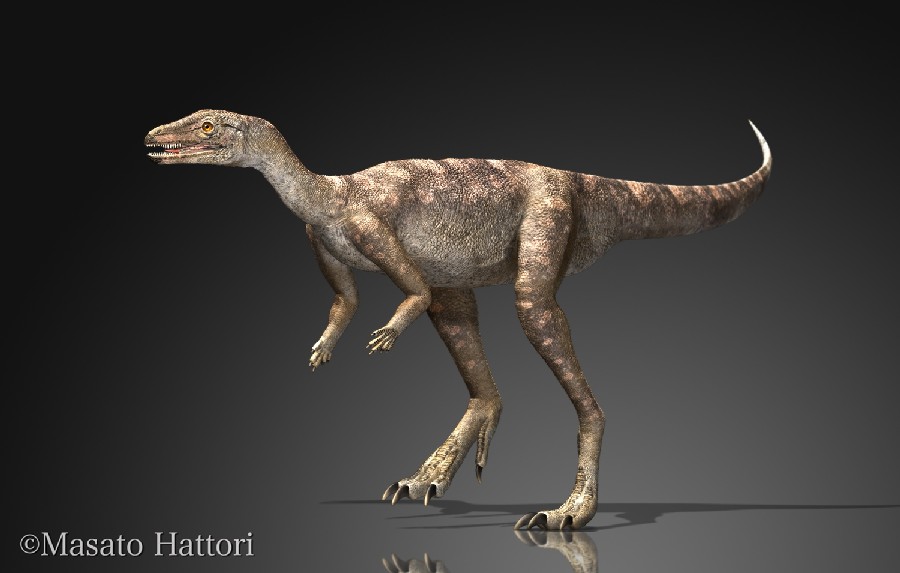|
|
Post by Talira Greycrest on Aug 12, 2021 6:24:58 GMT
It would be like getting hit with a rock. Probably best to stay clear of this dino's rear end! |
|
|
|
Post by Talira Greycrest on Aug 12, 2021 8:08:43 GMT
Name: ElmisaurusPronunciation: El-me-sore-usMeaning of name: "Foot sole lizard"Species: E. rarusSize: Unknown due to a lack of fossils.Family: CaenagnathidaeDiet: Unknown. Possible omnivore.First fossils found: Known only from a right hand and foot discovered by a joint Polish-Mongolian expedition to Mongolia's Gobi Desert in 1970. Named by Polish palaeontologist, Halszka Osmolska, in 1981.Lived: 83.6 to 66 million years ago during the Campanian and Maastrichtian stages of the Late Cretaceous in what is now southern Mongolia. Artist's impression of Elmisaurus Artist's impression of Elmisaurus
|
|
|
|
Post by Talira Greycrest on Aug 12, 2021 12:31:02 GMT
Today in dino history: The largest and most complete T-Rex skeleton was discovered in South Dakota, USA, on August 12th, 1990.
|
|
Tix Mascot
Tech guru
Italy is my second homeland
Posts: 11,078  Mini-Profile Background: {"image":"http://4.bp.blogspot.com/-X5mhw13BJ7Y/TwKeZ3uM7YI/AAAAAAAABPw/D82go4Ny_8E/s1600/italy-background-8-787281.jpg","color":""}
Mini-Profile Text Color: 0ef8f1
Mini-Profile Name Color: f40d39
Year of Birth: 1961
Nationality: Norwegian
Mini-Profile Background: {"image":"http://4.bp.blogspot.com/-X5mhw13BJ7Y/TwKeZ3uM7YI/AAAAAAAABPw/D82go4Ny_8E/s1600/italy-background-8-787281.jpg","color":""}
Mini-Profile Text Color: 0ef8f1
Mini-Profile Name Color: f40d39
Year of Birth: 1961
Nationality: Norwegian
|
Post by Tix Mascot on Aug 12, 2021 14:23:53 GMT
I'm amazed at the frequency so many finds turn up with.
|
|
|
|
Post by Joey12 on Aug 13, 2021 7:48:45 GMT
Before they are put in museum don't they make a copy of the bones and display the copy and save the bones so they don't get damaged?
|
|
|
|
Post by Talira Greycrest on Aug 13, 2021 8:16:54 GMT
Sometimes copies of the bones will be made so they can be displayed in other museums. The skeletons on display at my local museums aren't real bones but, later this year, we'll be getting a real genuine Triceratops skeleton. Here's today's entry: Name: ElrhazosaurusPronunciation: El-raz-oh-sor-usMeaning of name: "Elrhaz lizard", after the rock formation where its fossils were discovered.Species: E. nigeriensisSize: Unknown due to a lack of fossils.Family: DryosauridaeDiet: Herbivore. Likely fed on low-growing vegetation.First fossils found: Known only from a left thigh bone discovered by French palaeontologist, Philippe Taquet, in the Elrhaz Formation of Niger, West Africa, in 1973. Named by American palaeontologist, Peter Malcolm Galton, in 2009.Lived: 115 million years ago during the Aptian stage of the Early Cretaceous in what is now West Africa.
 Elrhazosaurus femur Elrhazosaurus femur |
|
|
|
Post by Joey12 on Aug 14, 2021 1:49:46 GMT
To me it's just as good seeing the copy. They can fix cracked bones and make it more realistic. Even aging the new cast making it look old. What I want to se is size and shape and they can do that with a copy.
|
|
|
|
Post by Talira Greycrest on Aug 14, 2021 7:37:47 GMT
Palaeontologists have confirmed the discovery of two new Sauropod species in northwest China, which have named Silutitan sinensis - "silu" meaning "Silk Road" in Mandarin - and Hamititan xinjiangensis, a nod to the region where it was found. Both incorporate the Greek word "titan," which means "giant," in reference to their size. They're thought to have lived from the Hauterivian stage through to the Aptian stage of the Early Cretaceous, between 130 and 120 million years ago.
|
|
|
|
Post by Talira Greycrest on Aug 14, 2021 8:02:08 GMT
Name: SauroniopsPronunciation: Sore-ron-e-opsMeaning of name: "Eye of Sauron", after the villain in 'Lord of the Rings'.Species: S. pachytholusSize: Unknown due to a lack of fossils.Family: CarcharodontosauridaeDiet: CarnivoreFirst fossils found: Known only from skull fragments discovered in the Kem Kem Beds of Morocco, North Africa (date of discovery uncertain). Named by Andrea Cau, Marco Dalla Vecchia and Matteo Fabbri in 2012.Lived: 100.5 to 93.9 million years ago during the Cenomanian stage of the Late Cretaceous in what is now North Africa.
 Artist's impression of Sauroniops Artist's impression of Sauroniops
|
|
|
|
Post by Joey12 on Aug 15, 2021 6:00:51 GMT
The more I see those long tails I think they were mostly for balance and used to attack when needed.
|
|
|
|
Post by Talira Greycrest on Aug 15, 2021 8:34:47 GMT
Today's entry is the first dinosaur to be discovered in Venezuela: Name: LaquintasauraPronunciation: Lah-kwin-tah-sor-rahMeaning of name: "La Quinta lizard", after the rock formation where its fossils were discovered.Species: L. venezuelaeSize: Estimated to have measured around 1 metre long, 25cm tall and weighing around 5kgs.Family: UncertainDiet: Herbivore. Fed on low-growing vegetation.First fossils found: Known only from a single, partial skeleton discovered in the La Quinta Formation of western Venezuela in 2014. Named in the same year by P. M. Barrett, R. J. Butler, R. Mundil, T. M. Scheyer, R. B. Irmis and M. R. Sánchez-Villagra.Lived: 201.3 to 199.3 million years ago during the Hettangian stage of the Early Jurassic in what is now western Venezuela.
 |
|
Tix Mascot
Tech guru
Italy is my second homeland
Posts: 11,078  Mini-Profile Background: {"image":"http://4.bp.blogspot.com/-X5mhw13BJ7Y/TwKeZ3uM7YI/AAAAAAAABPw/D82go4Ny_8E/s1600/italy-background-8-787281.jpg","color":""}
Mini-Profile Text Color: 0ef8f1
Mini-Profile Name Color: f40d39
Year of Birth: 1961
Nationality: Norwegian
Mini-Profile Background: {"image":"http://4.bp.blogspot.com/-X5mhw13BJ7Y/TwKeZ3uM7YI/AAAAAAAABPw/D82go4Ny_8E/s1600/italy-background-8-787281.jpg","color":""}
Mini-Profile Text Color: 0ef8f1
Mini-Profile Name Color: f40d39
Year of Birth: 1961
Nationality: Norwegian
|
Post by Tix Mascot on Aug 15, 2021 11:25:04 GMT
I wonder why so many had short fore limbs.
|
|
|
|
Post by Beach Bum Bec on Aug 15, 2021 16:10:37 GMT
Can they really use those short arms?  |
|
|
|
Post by Joey12 on Aug 16, 2021 6:26:28 GMT
They wouldn't make good boxers but then again look at how kangaroo's use their hind legs.
|
|
|
|
Post by Talira Greycrest on Aug 16, 2021 7:21:35 GMT
Can they really use those short arms?  Thankfully, most of them were able to use their arms for either walking on or getting food. However, some Theropods, like Carnotaurus, had arms that were so short, they were basically useless. |
|